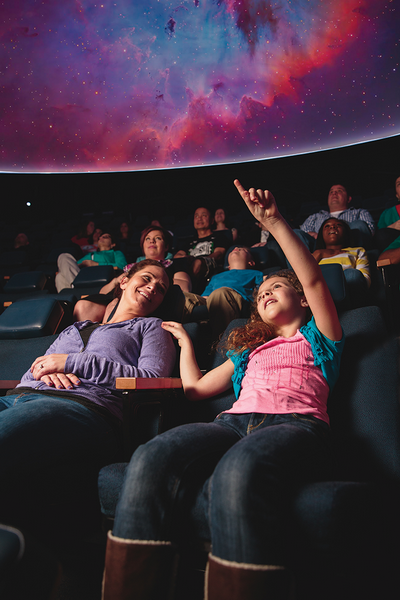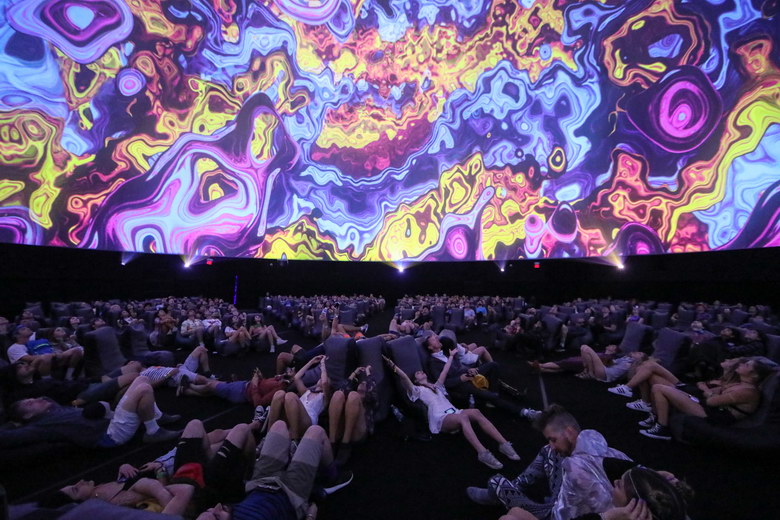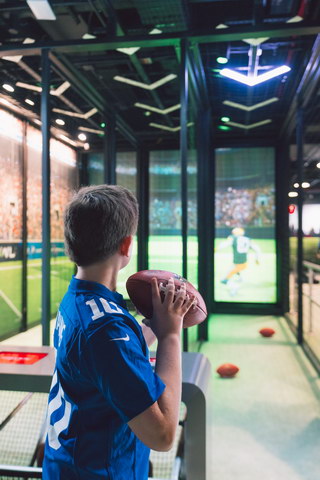The recent focus for “Immersive Experiences” has been on Virtual Reality (VR) Head Mounted Displays (HMDs). Let’s not forget there are other display technologies that can also provide immersive experiences, with no need for the viewer to wear a HMD.

With no HMD, the immersive experience can be shared with multiple other viewers and it can become a more collective experience.
Perhaps the best known of these alternative approaches is the full-dome theater. These theaters often started as planetariums at science-based museums, but have gone well beyond just showing stars. IMERSA (Immersive Media Entertainment, Research, Science & Arts) and the GSCA (Giant Screen Cinema Association) are two industry trade groups that favor full-dome and other large screen presentations.
 Enjoying a planetarium show at the COSI full dome theater (Credit: Christie Digital)
Enjoying a planetarium show at the COSI full dome theater (Credit: Christie Digital)
The 10th annual IMERSA Summit will be held at the Center of Science and Industry (COSI) in Columbus, OH on February 24 – 27, 2018. The Summit is said to bring together the planetarium, fulldome, VR, giant screen and themed entertainment communities. In addition to technical and business sessions and an exhibition, a major feature of the Summit, which is always held at a venue with a full-dome theater, is the screening of new, immersive, full dome content. The 211 seat COSI full dome planetarium theater was recently (2014) re-opened after a five year hiatus.
The upgraded projection system included an Evans & Sutherland Digistar 5 system that uses two Christie D4K2560 3DLP 4K projectors. Each projector has a resolution of 4096 x 2160, a 2000:1 contrast ratio and an output of 25,000 lumens. Like many planetariums, the star field is no longer generated by one of the classic Zeiss planetarium projectors but, instead, by the digital projectors. To do this successfully, the projectors not only need high resolution to image the small stars but a high contrast ratio to make the background between stars appear black, not grey. Kate Storm, the Director of Theaters at COSI, was enthusiastic about the new projectors because they could show alternative content in addition to the traditional star fields shown in a planetarium.
2018 Film Expo
The GSCA is holding its 2018 Film Expo March 12 – 13 at the Pacific Science Center in Seattle, Washington, which is the home of two IMax theaters and a Laser Dome. March 11, the day before the Expo opens, is reserved for meetings, including standardization committees and SIGs. While the detailed schedule has not been released, they expect to screen nine different giant-screen films. In addition, they have a three hour session in the theater for screening portions of additional films currently in production plus a second session for trailers of finished films not being shown in the Expo.
Note that “Films” may even be literally correct in some venues. One of the last holdouts of cinema film is the 70mm film used for giant screens. For example, I recently saw Dunkirk at the IMax theater on Broadway in New York on 70mm film. This theater was equipped with dual 70mm projectors for showing 3D content but has also been recently equipped with a pair of IMax RGB laser projectors. For Dunkirk, which was filmed in 2D, they were using just one of the 70mm projectors.
Until recently, digital projectors simply did not produce a high enough lumen output to fill giant screens and domes, hence the preservation of 70mm film. Note that the COSI dome uses two high output Christie projectors to provide both the lumens and the pixel counts needed. Other large screen venues use RGB laser projectors. The cost of either of these solutions is high and it is likely 70mm film will continue to be used in some of these giant screen venues until the venue operator can find a donor to buy modern, digital projectors.
 Inflatable Discovery Dome. (Credit: ePlanetarium)
Inflatable Discovery Dome. (Credit: ePlanetarium)
While many immersive domes are in fixed locations, other dome theaters are portable. For example, ePlanetarium makes what they call a “Discovery Dome”. These inflatable, portable domes come in diameters from 4M to 10M. The 8M dome, for example, will hold about 75 people and costs about $17,280. These domes are often used at schools for educational immersion. ePlanetarium also supplies software they call Fishtank. Fishtank allows the exhibitor to show all types of fisheye and full dome content from ePlanetarium and other sources. In addition, it will show any desired half of 360° video content from a laptop or Xbox, including immersive VR game content.
 The Antarctic Dome at the Coachella Valley Music and Arts Festival. (Credit: Christie Digital)
The Antarctic Dome at the Coachella Valley Music and Arts Festival. (Credit: Christie Digital)
The other end of the portable or temporary dome spectrum is represented by the 120’ (36.6m) Antarctic Dome that was custom built by Obscura Digital for the 2017 Coachella Valley Music and Arts Festival last April. This is said to be the largest geodesic projection dome in the world. This dome was powered by 15 Christie Boxer 2K30 projectors. A nine minute immersive program was shown to 500+ viewers simultaneously. A short video about the dome and the show is available on YouTube. I didn’t know anybody still made psychedelic content anymore but I guess it’s been a long time since I’ve been to a music festival! On December 12th, this installation won the award for the “Best Use of Technology at a Festival” at the first annual XLIVE x Everfest Festival Awards.
 VisiCube C4-4K four sided CAVE from Visbox Inc. Left: CAVE layout, Right: Examining a car crash from the inside in the VisiCube CAVE. (Credit: Visbox Inc.)
VisiCube C4-4K four sided CAVE from Visbox Inc. Left: CAVE layout, Right: Examining a car crash from the inside in the VisiCube CAVE. (Credit: Visbox Inc.)
Another glasses-free approach to an immersive environment is the CAVE (Cave Automatic Virtual Environment). The first CAVE was developed by Carolina Cruz-Neira and her colleagues at the University of Illinois, Chicago Electronic Visualization Laboratory in 1992.
A CAVE is a cube generally showing high-resolution images on at least three sides and all six sides are often used. Historically, these images were rear-projection but flat panel displays can be used instead, although even narrow bezels will reduce the “immersiveness” of a CAVE. In some cases, such as the floor of the VisiCube system, front projection can be used.
CAVEs are most commonly 3D so the CAVE user must wear active 3D glasses. (Due to the wide range of viewing angles, passive glasses generally cannot be used.) Typically, a CAVE will accommodate a small group, not just a single person. Some CAVEs use optical tracking of the person inside to adjust the image as he moves around. CAVEs are most commonly used for university or industrial data visualization, ergonomic research and other similar professional applications, not for consumer entertainment.
Part of this is a cost issue: some large CAVEs required four high resolution, high brightness projectors for each of the six sides while they can accommodate only small groups of three or four or so, depending on the CAVE size. Still, with the price of projectors dropping rapidly and the relative simplicity of CAVE systems like VisiCube’s, I can see how the technology could easily migrate into the location-based VR entertainment world.
 The Quarterback Challenge at the NFL Experience. (Credit: NFL Experience)
The Quarterback Challenge at the NFL Experience. (Credit: NFL Experience)
Finally, there are immersive mixed reality systems. Here, the user is surrounded by real objects but a portion of what he sees is virtual. I recently wrote about the NFL Experience (Subscription required) in Times Square. Many of the exhibits there could be classified as mixed reality and none of them required the viewer to don a HMD. For example, In the Quarterback Challenge, a visitor was challenged to throw a football to his favorite team’s tight end receiver. The football was real but the receiver and the stadium were virtual.
One of the advantages of immersive experiences that do not require HMDs for either education or entertainment is there is no need to manage the HMDs since none are involved. This eyewear maintenance issue was a serious problem for 3D, especially 3D TV and using 3D in education. Both active and passive glasses required effort on the part of the teacher or the exhibitor. 3D cinema can charge a premium which, in part, is used to provide the viewer with disposable passive glasses. This is not an option in the education market and in the TV market, where the set manufacturers preferred active glasses, the consumer simply didn’t want to bother.
The high cost of attending a location-based VR entertainment venue with HMDs is largely due to the fact that each attendee normally needs a full-time employee to manage and help the consumer don and adjust the HMDs. Glasses-free immersive environments bypass this problem. While even these glasses-free entertainment venues are still not cheap, after all the NFL Experience is $39, you can get an hour and a half or more of entertainment for your money at the NFL Experience compared to the few minutes a typical HMD-based VR experience provides. –Matthew Brennesholtz

